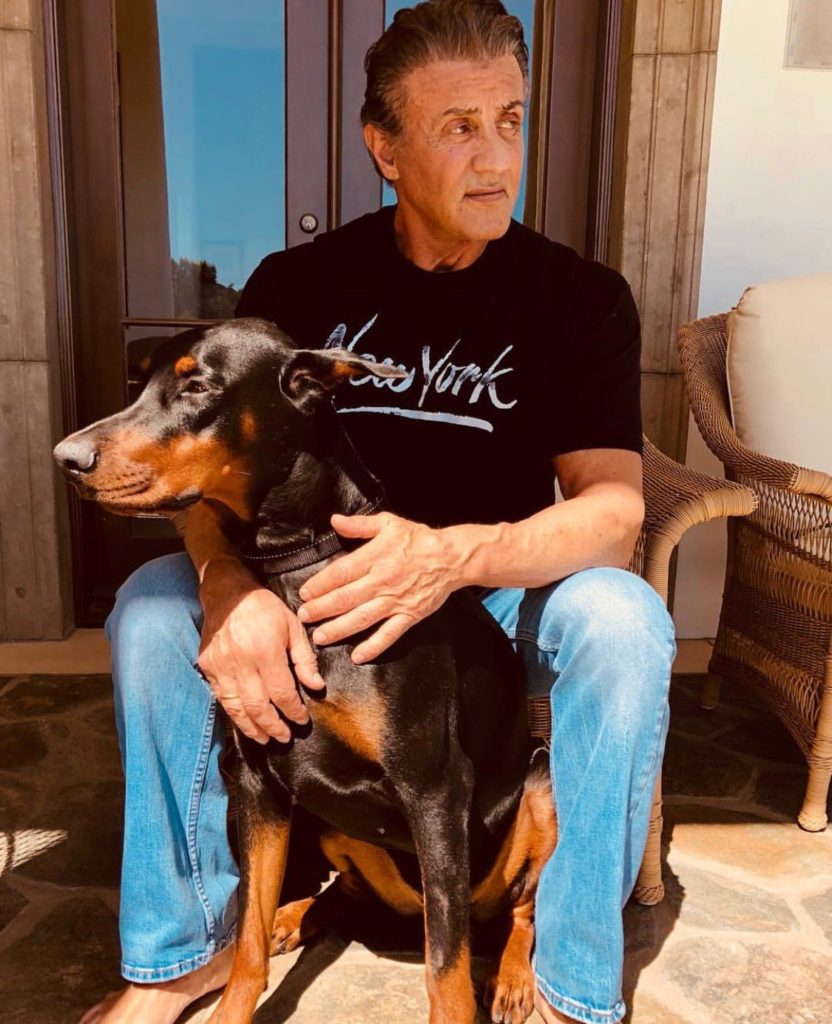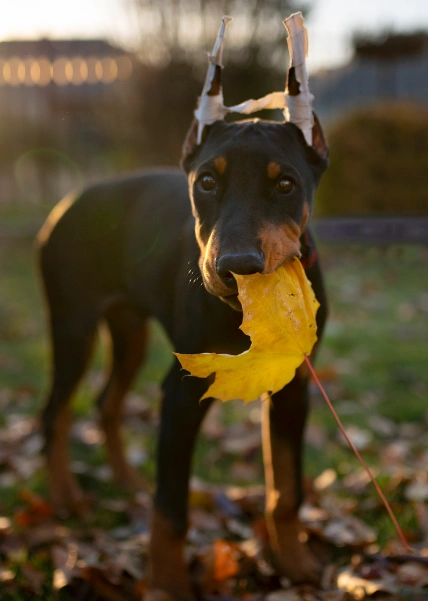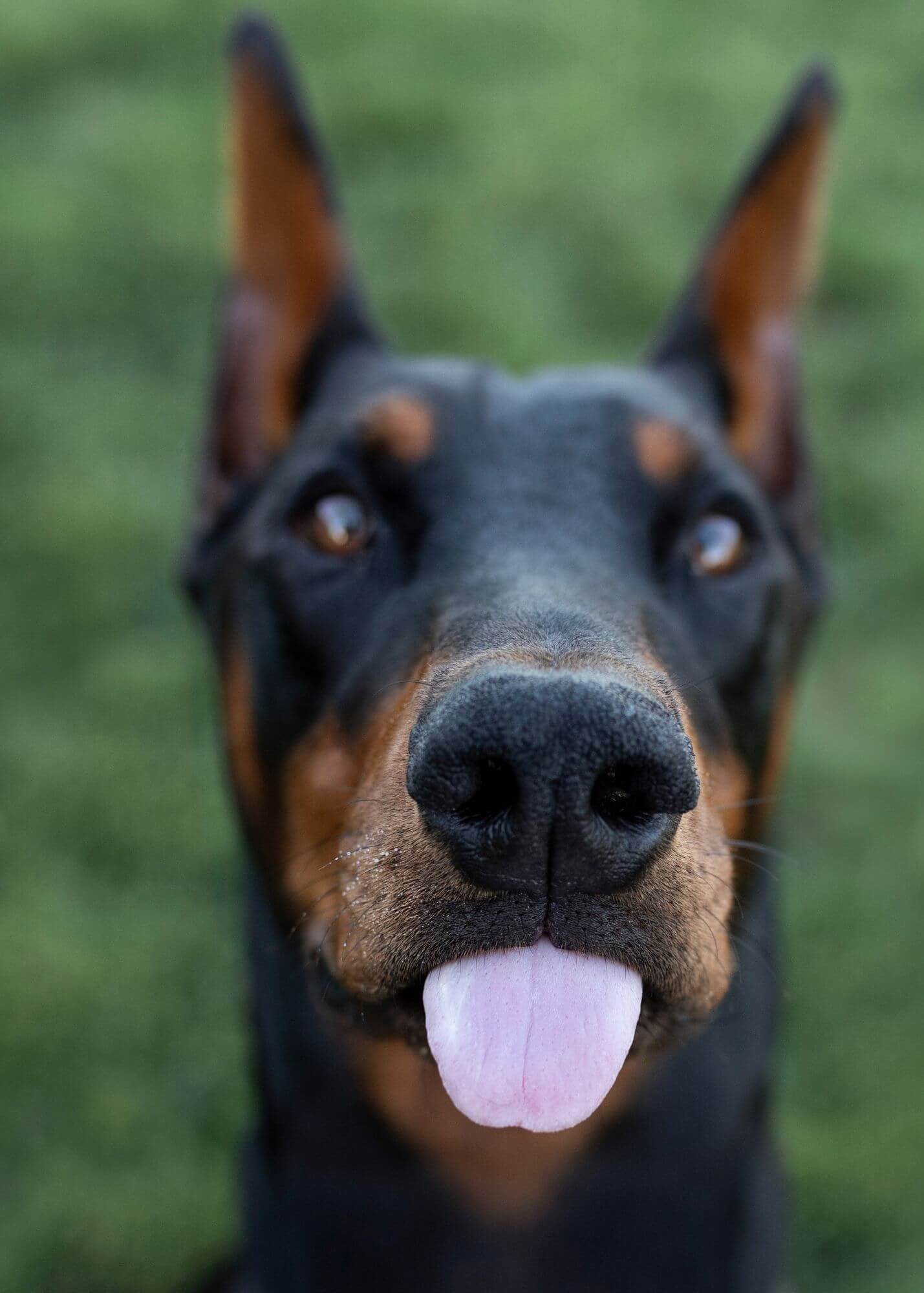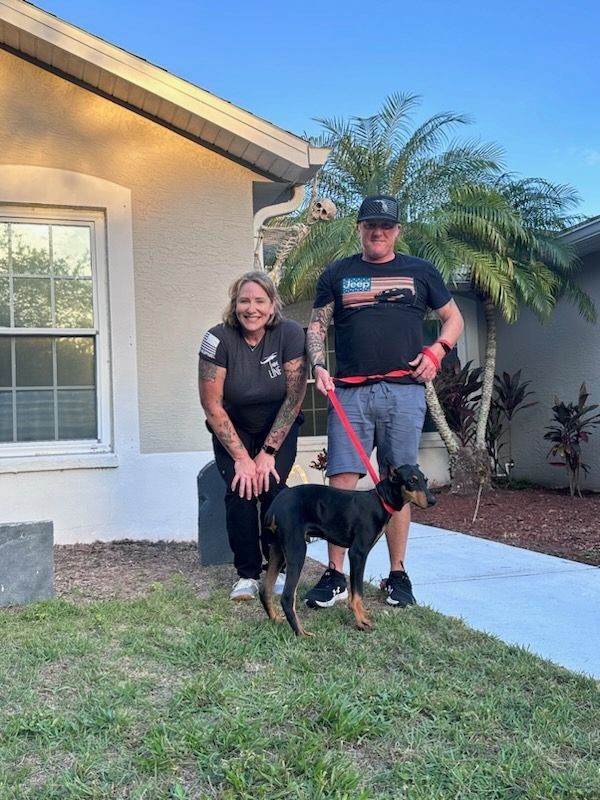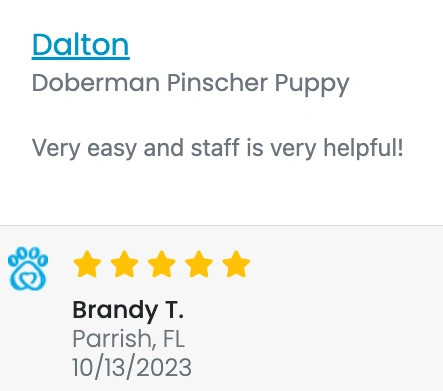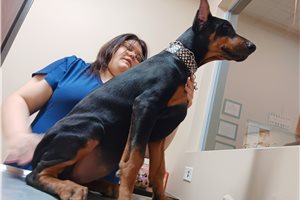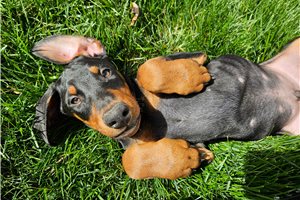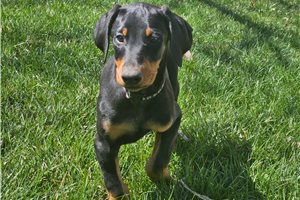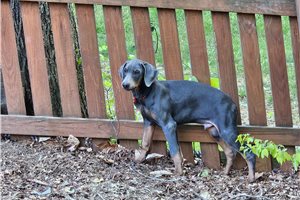You’re sitting at the edge of your movie theater seat as you distractedly eat your popcorn. A big bank heist is in progress, and vicious Doberman Pinschers lunge and jump at the chain link fence as the thief hops over making his successful escape. You see the glistening spit flying out of the long-toothed snarls as the dogs let out a string of ferocious barks and growls.
“Wow, how can people keep these intimidating dogs as pets?” you wonder.
“Not so fast!” your friend exclaims. “My neighbors have the absolute sweetest, funniest Doberman Pinscher. They get a bad reputation because of movies like this where they are always portrayed as vicious, but in reality, they’re amazing, loyal family dogs.”
Your friend is right! Doberman Pinscher puppies may look formidable, but they’re really athletic, elegant goofballs with a lot of love to give a family prepared to care for them.
Also called “Dobies,” Doberman Pinscher puppies belong to the Working Group comprised of dogs historically bred to help humans with various tasks, such as pulling sleds and carts, protection, and military work. In addition to being excellent guard and protection dogs, they are among the most noble and dignified dogs in the canine kingdom with their regal air about them.
Doberman Pinscher puppies require an experienced dog owner who understands how to socialize and train them properly. Unfortunately, Doberman Pinschers can have a bad reputation thanks to misrepresentation in popular culture found in movies and TV shows. People may be scared of them, so it’s your responsibility as a Doberman Pinscher puppy owner to understand the socialization and training needs of Doberman Pinscher puppies to ensure they grow up as well-adjusted dogs.
If you are up for the fun challenge of owning a loyal, protective Doberman Pinscher puppy, see what it’s like to live with one to determine if a Doberman Pinscher is the right puppy for you.
A Marine dog handler and his Doberman Pinscher war dog on the island of Saipan, 1944.
The History and Origin of Doberman Pinscher Puppies
In the late 19th century, an entrepreneur named Karl Friedrich Louis Dobermann from Apolda, Germany developed the Doberman Pinscher. Dobermann held multiple jobs, including tax collector and dog catcher, where he had access to popular working dogs called “butcher dogs.” He selected a type of shepherd dog and bred it to Rottweiler-like butcher dogs, creating a distinct breed he named the Dobermann, the only German dog to carry its maker’s name. By breeding the best physical appearance and determined work ethic, Dobermann’s Dobermans were perfect guard dogs as he went around collecting taxes, often a dangerous profession.
The Doberman Pinscher became known as a loyal, alert, and highly protective dog used in home and work settings. Not only did they gain a reputation for being excellent police and guard dogs but they also hunted and caught large vermin, making them versatile, useful canines.
Around the 20th century, the Doberman Pinscher was bred with Greyhounds and Manchester Terriers to bolster the sleek look and bold personality. Some people now refuse to say “Pinscher,” dropping it because it is no longer a true terrier, and the second N of Dobermann’s name was lost at some point. The first Doberman Pinscher was shown for judging in 1897. Their worldwide popularity grew outside Germany so much that the US Marine Corps named it their official war dog after seeing how the breed demonstrated courage and bravery in the trenches of both World Wars. In fact, during World War II, approximately 75% of dogs used during combat were Doberman Pinschers.
Today, Doberman Pinschers are known as proud, refined guard dogs with a tireless work ethic used all over the world for protection and kept as family companions. Famous people who have enjoyed the company of Doberman Pinschers as companions include Sylvester Stallone, Bea Arthur, Kevin Hart, Nicolas Cage, Mariah Carey, Hunter S. Thompson, and Forest Whitaker just to name a few.
Characteristics of Doberman Pinscher Puppies
Doberman Pinscher puppies grow up to be 60-100 lbs. and will stand 24-28 in. tall depending on the sex of the dog. Their wedge-shaped heads, elongated necks, giant paws, and striking muscular physique create a dignified, distinguished look. Their ears are usually cropped but can be left natural, and their tail can curl above the back or be docked at the second joint. A Doberman Pinscher will deter any intruder by looks alone, especially when lunging with bared teeth and cropped ears standing straight up on its head.
Most people may picture a black and rust-colored Doberman Pinscher, but they also come in blue & rust, fawn (Isabella) & rust, red & rust, and the rarest, all-white. Some Doberman Pinschers may also have a small white patch on their chests. Their single, short coat is smooth and sleek and doesn’t require much care other than occasional brushing and bathing to keep them glossy and clean. However, just because their hair is short doesn’t mean they don’t shed – Doberman Pinschers are moderate-to-heavy shedders, especially twice a year when they blow out their coats to make room for new hair growth. Keep those lint rollers handy!
American vs. European Doberman Pinschers: What’s the difference?
Among some dog breeds, you’ll find variations classified under one dog breed. For example, there are five types of German Shepherds; English, conformation, and field Golden Retrievers; and American and English Cocker Spaniels. The Doberman Pinscher is no different and can be either an American or European variety.
European Doberman Pinschers (sometimes spelled “European Dobermann”) are slightly larger and more muscular with dark brown eyes, a thicker bone structure, a wider, blockier head, big paws, a very deep chest, and shorter neck than the American variety. European Dobermans are judged based on the official FCI Dobermann breed standard.
An American Doberman Pinscher is typically smaller with lighter markings, a more narrow head, small paws, and a sleek, long, and lean build. The American Kennel Club Doberman breed standard is used when judging American Doberman Pinschers.
Regarding temperament, both European and American Doberman Pinschers make intelligent, loving pets. European Doberman Pinschers typically have a higher work drive, stamina, and confidence level than the more docile American Doberman Pinschers. In the show ring, American Doberman Pinschers are more likely to be successful in conformation events, while European Doberman Pinschers are more suited to protective sports and working events.
Regardless of your Doberman Pinscher’s “nationality,” you know you’ll be getting a fiercely loyal and protective companion who bonds deeply to their family when you adopt a Doberman Pinscher puppy.
Ear cropping
One of the signature features of a Doberman Pinscher is their tall ears that stand straight up on top of their heads. However, they are not born with naturally pointy ears. Ear cropping on Doberman Pinschers is an elective surgery performed at 7-9 weeks of age and does not serve a particular health purpose, nor is it a mandatory part of owning a Doberman Pinscher puppy. According to AKC standards, a Doberman Pinscher’s ears are “normally cropped and are carried erect.” Owners may opt to crop ears to conform to breed standards if they are utilized as show dogs, for their role as working dogs, or cosmetic purposes.
There are pros and cons to this elective procedure, and potential Doberman Pinscher puppy owners need to weigh their options before considering ear cropping. After the surgery, carefully wrapped tape holds up the healing ears in a process called ear posting until they are fully healed and stand upright thanks to a thickening of the ear cartilage, which continues with age. The procedure takes about 30 minutes and is done under general anesthesia with pain medication administered until the puppy is comfortable once again.
What’s the Personality Like of Doberman Pinscher Puppies?
Doberman Pinscher owners will tell you there is nothing dull or boring about owning a Dobie puppy! Here are some personality traits and quirks that make owning a Doberman Pinscher puppy so special.
Always watching
If you think you can sneak by a Doberman Pinscher, owners will swear they sleep with one eye open, always at the ready to watch out for potential threats. They are one of the most alert dog breeds and are prepared to “tell” you what may be dangerous.
Bold and confident
Doberman Pinscher puppies are assertive and not typically ones to hang back to silently observe first. When encountering a new situation, they will not cower in the corner in fear. Rather, they will assertively assess the situation, ready to defend their loved ones, and won’t hesitate to be physically protective if needed.
Goofy and hilarious
Doberman Pinschers may have a reputation for being fierce, but they’re actually giant goofballs that will have you holding your sides from laughing so hard. Their long, pink tongues and big mouths practically seem to smile widely, and the way they can jump up and down as if they have springs in their paws is quite the sight to behold. Doberman Pinschers also like to get into some shenanigans, especially as puppies, so watch out for their bumbling blunders as they grow into their long legs and learn manners.
In tune with their humans
Doberman Pinscher puppies have amazing expressions, deep, soulful eyes, and turn their heads in ways you swear they understand exactly what you are saying. They are very in tune with human emotions and will be quick to provide comfort if you are upset and celebrate with you in moments of triumph.
Loyal to a T
When socialized and raised properly, Doberman Pinscher puppies are sweet, loving, and loyal dogs affectionate with their families. They may bond with one special person in the family or hold everyone as their favorite. Doberman Pinscher puppies view children as their responsibility to love and protect. They are excellent family dogs that are tolerant of children and great playmates when supervised properly.
Snugglebugs
Doberman Pinschers are very loving towards their owners. They like being your shadow, so get used to your “velcro” dog going wherever you go, even if that’s to the restroom! The phenomenon even has a name called the “Dobie lean” when they want attention, putting all their weight on you as they lean right into you. They love getting cozy on a soft bed or special blanket as long as it’s in a spot next to you. They may hog the couch or think they’re lap dogs when you’re trying to relax after a long day. Scoot over because your spot will be taken by a giant cuddle monster! And if you dare stop petting them, you may get a cold, wet nose to the hand or arm.
Training and Socializing Doberman Pinscher Puppies
Many people love the idea of Doberman Pinscher puppies growing up to protect you and your household. However, you cannot just leave it up to nature to dictate the protective nature of your Doberman Pinscher puppy.
It’s vital to begin training your Doberman Pinscher puppy the day you bring them home. Begin with basic commands using positive reinforcement and lots of praise. While Doberman Pinscher puppies are intelligent and eager to please, they can have a stubborn streak.
However, never use harsh methods to train your puppy, even if you choose to train them in protection sports. While some techniques may appear harsh, proper training will not harm a dog or break their spirit. In the video we shared, you can see an example of a highly trained Doberman Pinscher learning to avoid intense distractions and only listening to its owner’s commands to act. The dog is never in danger of being harmed, and the bait person is also trained to receive bites wearing protective gear.
Obedience and protection sports
It’s highly recommended that you move to a canine activity beyond basic obedience training starting around 4-9 months. These dogs are built to work and will need lots of focus for their high-energy needs. Two activities that Doberman Pinschers excel in are obedience training and protection sports.
The Protection Sports Association (PSA) is an organization that provides an outlet for civilian competition in canine obedience and controlled protection. They encourage partnerships with other K9 sports aiming for excellence, sportsmanship, and integrity throughout the dog training community. One unique aspect of this particular dog sport is that dogs don’t necessarily compete against one another as much as they do against the sport, so the relationships made with other handlers and dogs are not clouded by competition and jealousy. Dogs and handlers try their best to achieve titles in different levels of the sport, called PDC, PSA1, PSA2, and PSA3.
Each level requires a variety of obedience and protection exercises. Dogs and handlers will encounter attacks, car-jacking scenarios, tests of courage and environmental stability, searching exercises, call-offs, a muzzle attack, or a searching activity. The fully-suited handlers are often fellow trainers or police K9 handlers and must be certified to participate.
The difficulty of tasks asked of dogs and handlers increases with each level. At the highest level (PSA3), judges will throw in one of five surprise random scenarios on the trial day to see how well dogs listen to their owners.
To the untrained eye, these types of dog sports seem like they could be violent, but under proper training, the Doberman Pinscher is living his best life out there serving and protecting doing exactly what he’s meant to do in a controlled environment.
Caring For Your Doberman Pinscher Puppy
The Doberman Pinscher breed is a relatively healthy dog breed that can live 10-12 years with proper care, high-quality nutrition, and plenty of exercise.
How much exercise does a Doberman Pinscher puppy need?
Because Doberman Pinscher puppies are top members of the Working group, they will always need a “job” to do. This means you will need to be prepared to exercise your Doberman Pinscher at least 1-2 hours a day, with both physical and mental stimulation opportunities.
A key factor in your Doberman Pinscher puppy’s behavior is directly correlated to the amount of exercise they receive. A tired Doberman is a happy Doberman! If you don’t take the time to give them what they require, Doberman Pinscher puppies will provide their own entertainment in ways you might not consider to be so fun. If they have no outlet for their energy or a way to direct it, you could be facing excessive barking, chewing, digging, anxiety, property destruction, and an increasingly aggressive temperament.
Health concerns
There are some health concerns Doberman Pinscher puppy owners should know before looking for a Doberman Pinscher puppy to ensure you are aware of potential conditions. Watch out for the following:
- Bloat, also called Gastric dilatation and volvulus (GDV), is a potentially fatal condition where the stomach fills with gas and twists upon itself, blocking both entrances to the stomach. Bloat is common in deep-chested breeds, and owners can try to prevent it by learning ways to slow down your puppy while eating, reducing stress, and monitoring during meals. Call your emergency vet right away if you suspect bloat in your Doberman Pinscher puppy.
- Hip and elbow dysplasia occurs when joints experience growth disturbances and do not fit together properly. Hip and elbow dysplasia can cause pain, osteoarthritis, and reduced range of motion.
- An inherited blood clotting disorder called von Willebrand's disease is common in Doberman Pinschers and causes a mild-to-moderate bleeding risk. While there is no cure, it can be properly managed.
- Other genetic health conditions include dilated cardiomyopathy (enlarged heart), progressive retinal atrophy, albinism, and hypothyroidism.
Where Can I Find Doberman Pinscher Puppies?
Some people may view Doberman Pinschers as some sort of status symbol to own rather than as living beings that need proper care, love, and attention. Because of their reputation as fierce dogs, backyard breeders and puppy mills will sell litters with no healthcare, health guarantee, papers – anything to make a quick buck. They won’t care if the buyer uses them to fight or has no plans to properly train this brilliant dog breed.
When you turn to a full-service puppy concierge adoption experience like Pawrade, you can rest assured your Doberman Pinscher puppy will come from reputable breeders that are pre-selected after a rigorous application review. We offer a 100% scam-free process to provide a secure and transparent adoption journey for both breeders and pet-seekers.
But don’t just take our word for it. Check out our TrustPilot reviews from happy customers who might have been scammed in the past and are blown away by our secure, professional puppy-adopting experience.
We can’t wait to help you select the right puppy for you when you search our Doberman Pinscher puppies for sale. Let our Puppy Concierge Team help you every step of the way until you’re holding your Doberman Pinscher puppy in your arms.


